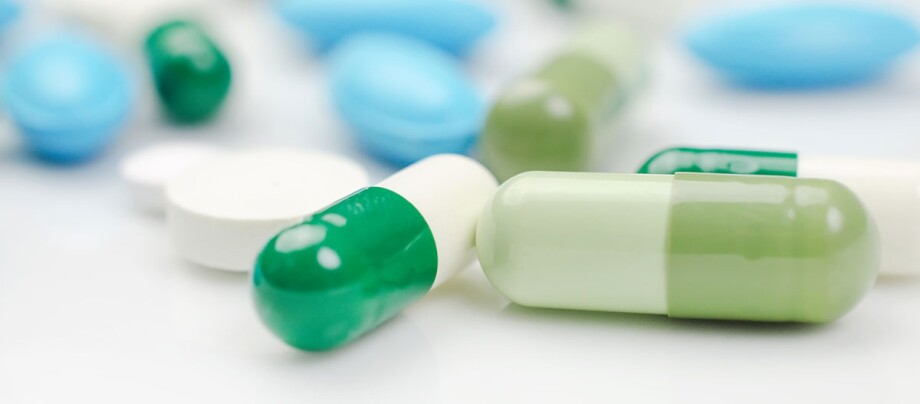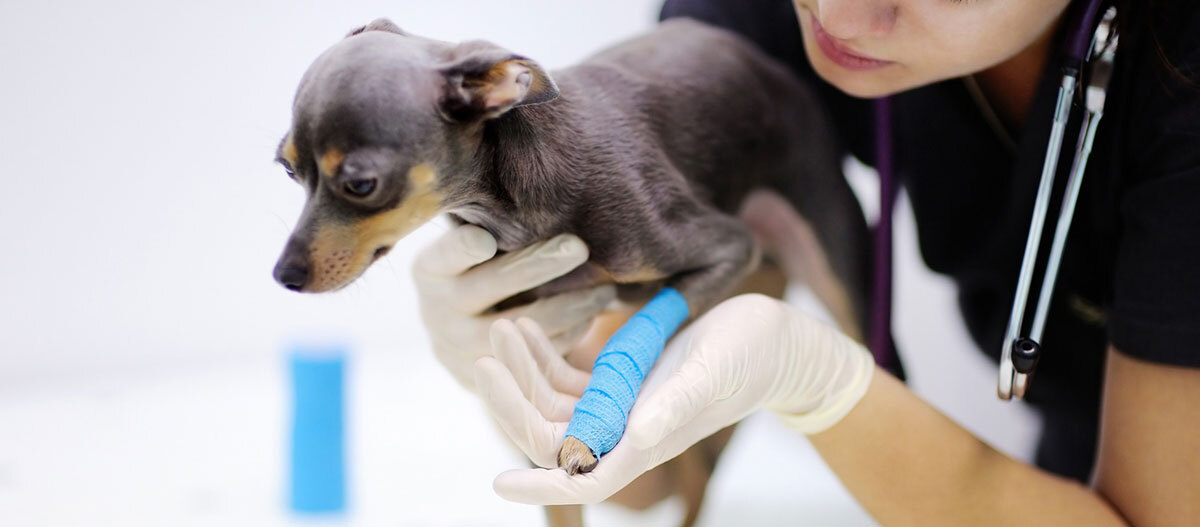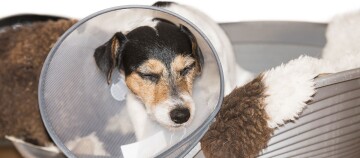Dog First-Aid Kit and Portable Emergency Kit for When You Are on the Go
11.03.2025 - Reading time: 6 minutes

Unfortunately, diseases and accidents can’t be avoided, but the right action in an emergency can prevent pain and reduce complications. Read here to find out what should go into a home first-aid kit for dogs and a portable emergency kit for when you are on the go
- First-aid kits for dogs and what you can treat with it
- Everyday dangers for dog health
- Putting together your dog first-aid kit correctly
- What belongs in a dog first-aid kit and why?
- First-aid for dogs on the go – what do you need?
- Emergency issues: poisoned bait, slug pellets, rat poison and other household poisons
- What should I do if my dog has eaten poisoned bait?
The dog pharmacy and what you can treat with it
With a dog first-aid kit, you can treat smaller accidents or illnesses in your dog that are not life-threatening situations. These include minor digestive problems, stressful situations on New Year’s Eve or during longer (car) journeys. In emergencies, you can also save your dog’s life if you act quickly with first-aid measures and the necessary equipment.
Everyday dangers for dog health
An accident can happen faster than you can blink. Some of the most common hazards in a dog’s daily life include:
Some of the most common hazards in a dog’s daily life include:
- Paw injuries due to splinters or glass shards
- Tick bites
- Split claws or torn dewclaw
- Accidents in the home, such as burns in the kitchen, trapped tails or paws, or swallowed objects
- Minor, but also life-threatening poisonings due to poorly tolerated foods, cleaning agents, human medications, or poisoned bait.
In these cases, it is essential to act fast and get to a vet!
Putting together your dog first-aid kit correctly
You can equip your individual dog first-aid kit with the help of your vet so that it best corresponds to your dog’s needs. That is especially important if your dog has any intolerances to medications or foods or any chronic diseases.
What belongs in a dog first-aid kit and why?
Dogs in shock and in great pain can be unpredictable. That’s why a rubber muzzle or a gauze bandage can be helpful for first-aid.
To care for wounds, you need bandage materials, consisting of an alcohol free disinfectant, ointment, gauze bandages, sterile gauze pads, cotton wool, adhesive bandages, sticking plasters, and a pair of bandage scissors.

Maria Sbytova/stock.adobe.com
A disposable syringe without a needle helps to apply disinfectant in a targeted way, or to administer medicine or fluids to a dog.
In case of a paw injury, baby socks or dog shoes are practical ways to protect the wound.
Ear-cleaner can be used if the dog scratches its ears or shakes its head often. That can be a sign of an infection, which can be more easily recognized in a clean ear. Small foreign objects can also be rinsed out. If the symptoms continue, you should see a vet to prevent more serious diseases in the middle or inner ear.
You can find out whether your dog has a fever using the digital thermometer, which you insert into the dog’s anus with a small amount of vaseline. The normal measurable body temperature of a dog is between 37.5 and 38.5°C. Puppies and excited dogs, however, can have a temperature of up to 39.5°C without being ill.
The summer heat can also cause a high temperature in thick-furred or stressed dogs. You can relieve this overheating by spraying the fur with some water, putting on a cooling collar, or offering a cooling blanket to lie on. A simple method is to put a wet t-shirt on the dog. But make sure that the t-shirt is always wet, otherwise it’s counterproductive!
The summer heat can also cause a high temperature in thick-furred or stressed dogs. You can relieve this overheating by spraying the fur with some water, putting on a cooling collar or offering a cooling blanket to lie on. A simple method is to put a wet t-shirt on the dog. But make sure that the t-shirt is always wet, otherwise it’s counterproductive!
Dog first-aid kit checklist for the home:
- Disposable gloves
- Gauze bandages and sterile gauze pads
- Cotton wool
- Adhesive bandages
- Bandage scissors
- Disinfectant without alcohol for wound disinfection
- Wound ointment
- Activated charcoal
- Ear-cleaning agent (without an active ingredient, such as antibiotic or cortisone)
- Disposable syringe without needle
- Baby socks or dog shoes
- Tick tweezers/tweezers
- Flea repellent/insect repellent
- Worming tablets
- Thermometer
- The telephone number of your vet or animal clinic, as well as a veterinary emergency service!
Talk to your vet about emergency medications for your dog first-aid kit to see if they are suitable for your pet:
- Light, natural calming products for animals that are appropriate for stressful moments in a dog’s life (fireworks, restlessness after a bite or other injury, car trips).
- Insect bite cream prescribed by your vet. Please make sure that your dog does not lick the ointment off.
- Anti-inflammatory, cooling or pain-relieving gel for sprains prescribed by your vet
- Some dogs respond very well to homeopathic preparations, such as colloidal silver available at your local Maxi Zoo stores
Regularly check the contents of your dog first-aid kit for the expiration dates.
First-aid for dogs on the go – what do you need?
Every dog owner should have a first-aid kit for dogs in their bag or car.
Portable first-aid kit checklist:
- Gauze or adhesive bandages: for treating wounds, also as a makeshift muzzle or lead, if necessary
- Pressure bandage
- Large bandage for wound care
- Adhesive bandages
- Bandage scissors
- Wound ointment
The faster a tick can be removed from a dog’s body, the lower the risk of the transmission of dangerous pathogens. There’s no reason not to get rid of the tick right away and disinfect the affected area of the dog’s body with alcohol free disinfectant. A pair of tick tweezers is an essential addition to your kit.
Raw paw injuries are common in the winter or in the summer at the beach. Baby socks or dog shoes can be very helpful in such cases.
Emergency issues: poisoned bait, slug pellets, rat poison, and other household poisons
Hopefully, you and your dog will never experience these emergency situations: your dog has eaten poisoned bait, rat poison, or medications from your nightstand.
Apart from maliciously placed poisoned bait, rat poison and slug pellets are the worst dangers for pets. With both types of poison, sometimes even just sniffing the bait can be enough to cause poisoning! You should be particularly vigilant when you see white or colorful little balls on the ground. These might be slug pellets. The poison in slug pellets takes effect much faster than rat poison, the symptoms of which only become apparent several hours later.
Everyday household items can also be poisonous for pets. A bucket of water with cleaner, chocolate, grapes, or an open toilet bowl with cleaner in it can be lethal for curious or thirsty dogs and puppies

Barbara Helgason/stock.adobe.com
Poisons can also be found outdoors, such as pesticides. They are not only dangerous for insects but also for dogs. Young, old, or sick dogs can be poisoned after walking outside if they come into contact with plants or fields that have been treated with pesticides. It’s best to find out in advance when pesticides are being used along your route and to avoid this area for several days.
Be careful with your medications too, such as pain relievers, psychiatric drugs, sleeping tablets, or hormone medication as they all represent a significant risk of poisoning for your dog!
A lot of food that is healthy for us can be poisonous for dogs. This includes chocolate, raw pork (due to possible Aujeszky’s disease), any kind of nightshade plants (raw potatoes, tomatoes, aubergines, peppers), sweet potatoes, onions, avocados, pitted fruit (the pit is dangerous if swallowed), coffee, and alcohol (including beer). Even small amounts of these substances can be lethal for dogs, depending on their size, breed, or pre-existing conditions.
A lot of food that is healthy for us can be poisonous for dogs. This includes: chocolate, raw pork (due to possible Aujeszky’s disease), any kind of nightshade plants (raw potatoes, tomatoes, aubergines, peppers), sweet potatoes, onions, avacado, pitted fruit (the pit is dangerous if swallowed), coffee and alcohol (including beer). Even small amounts of these substances can be lethal for dogs, depending on their size, breed or pre-existing conditions.
What should I do if my dog has eaten poisoned bait?
If your dog has been poisoned, rapid administration of activated charcoal can reduce the effects of the poison. You should immediately seek out a vet and bring along any vomit or excrement and the poisonous substance itself.
Important note
The information given in this guide is not intended to be a substitute for a visit to the vet. It should not be used as the sole basis for health-related decisions. A vet should always be consulted in emergencies.


